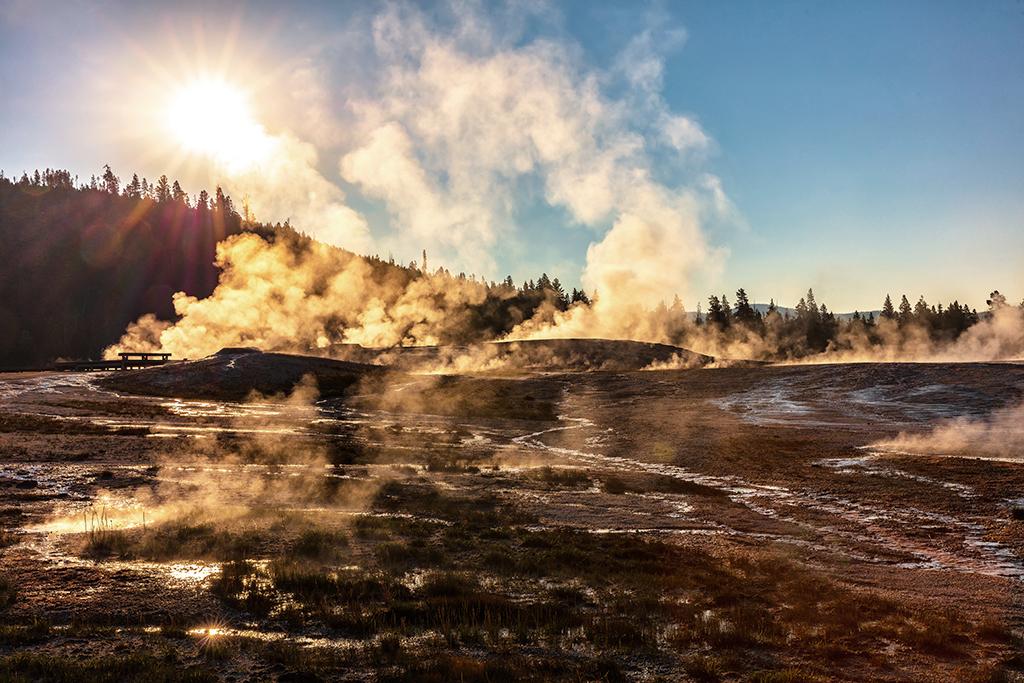
Morning light over Upper Geyser Basin, Yellowstone National Park / Rebecca Latson
As mentioned in my January article, I turned my move from southeast Texas to central Washington into a three-week photographic road trip, visiting Petrified Forest National Park, Glen Canyon National Recreation Area, the North Rim of Grand Canyon National Park, Bryce Canyon National Park, Grand Teton National Park, and Yellowstone National Park. I’ll say this for traveling during the summer: It’s crowded at these places. OK, maybe not so much at Petrified Forest. That national park is a less-populated gem about which I wrote in a previous column. Yellowstone, on the other hand, was far and away the most crowded national park I’ve yet to visit. Although I never was able to see all the sights on my list because there was no parking anywhere after about 8 a.m., that did not stop me from capturing some amazing images, not only of a few iconic locations, but also of scenes and subjects I observed around me, far from any geyser. I made the most of my photo ops in whatever vicinity I happened to find myself for the day, and I want to share what I saw and learned from my short, very crowded stay in America's first national park.
Yes, I did photograph within some of the iconic locations, such as Upper Geyser Basin, Biscuit Basin, Fountain Paint Pots Nature Trail, and Mammoth Hot Springs.

The colors of Morning Glory Pool, Yellowstone National Park / Rebecca Latson
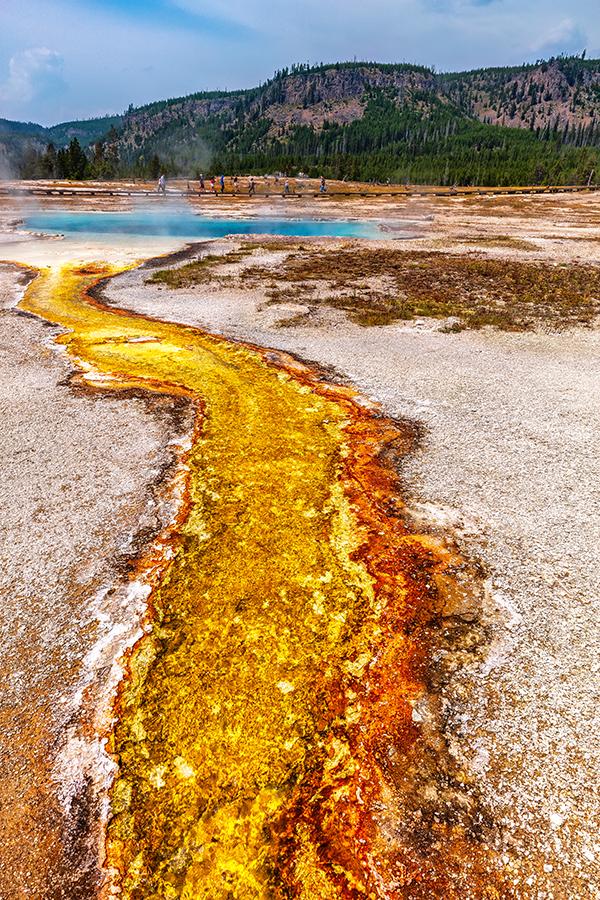
A bacterial vein leading line at Biscuit Basin, Yellowstone National Park / Rebecca Latson
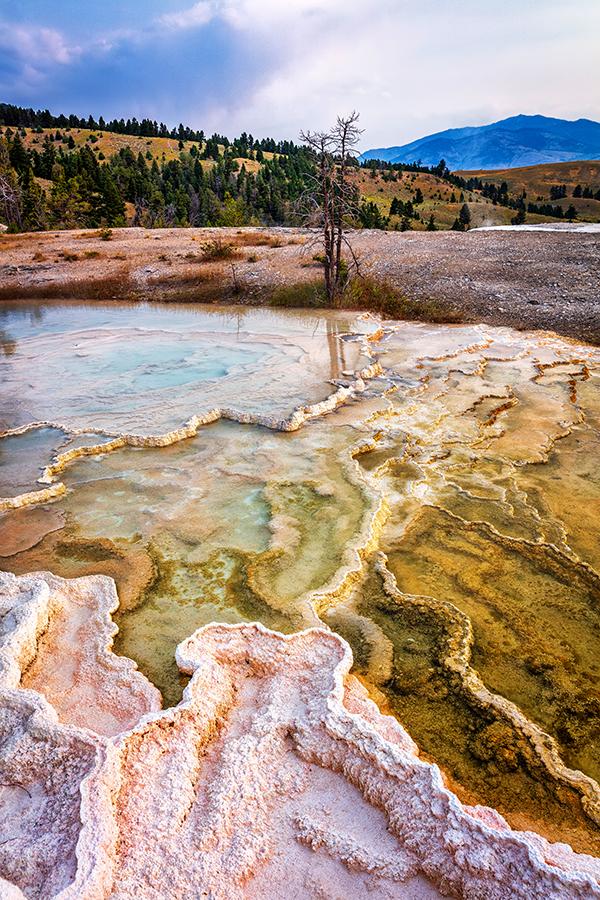
Mammoth Hot Springs terraced pools, Yellowstone National Park / Rebecca Latson
Yes, I did see a little bit of wildlife, too (no bears or wolves and definitely not enough bison sightings to suit me).

One eye open on the competition, Yellowstone National Park / Rebecca Latson

Coming in for a landing, Yellowstone National Park / Rebecca Latson
However, not being able to view and photograph such sights as Grand Prismatic Spring, Artist Point, or Upper and Lower Yellowstone Falls compelled me to keep my eyes open to the beauty immediately around me.
I’m sure I’ve mentioned this before: Observation is the key to every photo op in any national park. It's what makes for a great composition. With an area of 3,471 square miles, there’s plenty to observe beyond geysers, bears, and wolves in Yellowstone. For instance, shortly after driving through the south entrance, I noticed a lovely, quiet lake partially hidden by a line of trees. Parking at a pullout, I peered through the trees toward the lake for the shot below. The sun was peeking through the trees, too, forming a single point source that I used to create a sunburst.

A sunburst and a quiet little lake through the trees, Yellowstone National Park / Rebecca Latson
Walking a little further beyond those trees, I stood along the lake's shore to photograph the reflections on the mirror-smooth water.

Reflections on a quiet lake, Yellowstone National Park / Rebecca Latson
Further up the road, I noticed small ponds latticed with floating yellow lilies.

A yellow pond lily and its reflection, Yellowstone National Park / Rebecca Latson
Layers of scenery met my eyes: meadow, water, short trees, taller trees, hills, mountains.

Yellowstone layers, Yellowstone National Park / Rebecca Latson
Yellowstone is famous around the world for its geothermal activity, with reminders of an almost-constant smell of sulfur in differing degrees of pungency, as well as the sight of steam issuing from cracks and vents. During the morning hours, in some locations, steam can fog the landscape for a short time, creating ephemeral compositions before dissipating. When you visit this national park and encounter this foggy veil, make use of the atmosphere to give your images a haunting, otherworldly feeling.

Early morning geothermal "fog," Yellowstone National Park / Rebecca Latson

Ephemeral mist on the landscape, Yellowstone National Park / Rebecca Latson
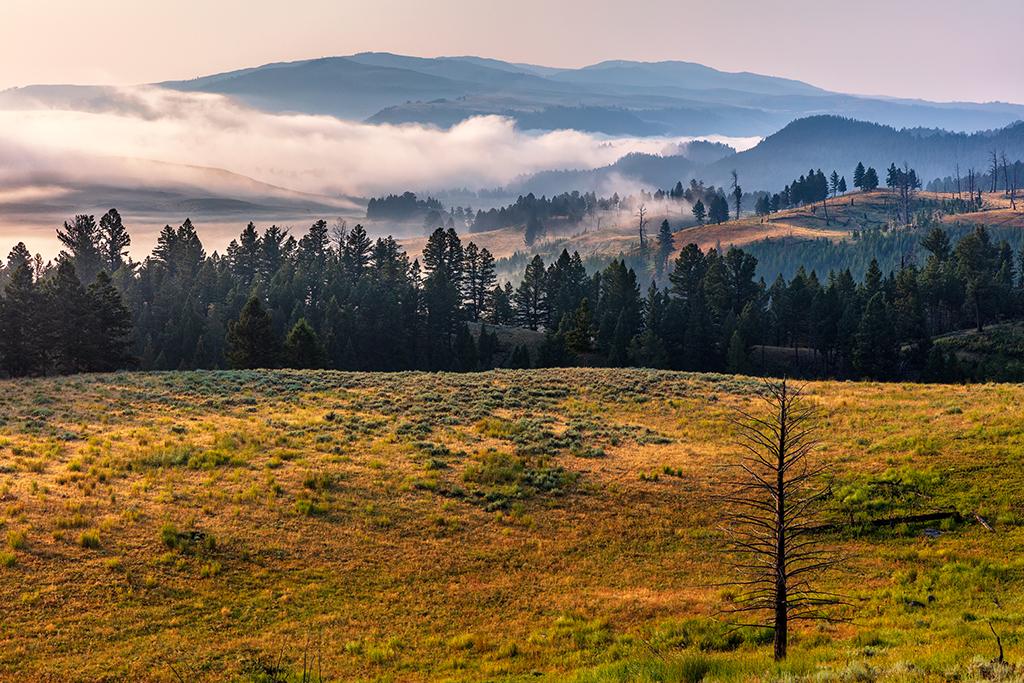
Early morning scenery, Yellowstone National Park / Rebecca Latson
Sunrise in Yellowstone is a splendid sight, as are pre-dawn "blue hour" shots of such scenery as Blacktail Pond, along the road from Mammoth Hot Springs to Tower-Roosevelt Junction. A tripod is recommended for both pre-dawn and sunrise images, since both are low-light environments requiring an increase of your camera's ISO and a shutter speed slow enough that you would blur your composition if handholding your camera. You might want to use your camera's 2-second timer for a slight delay between the moment your finger presses the button and the shutter clicking. This short delay helps prevent vibration your finger causes as it pushes the shutter button. A shutter release remote, wireless or corded, will work just as well.
Use a grad ND filter to prevent overexposing (aka "blowing out") the brighter upper portion of your composition as the sun climbs into the sky.

Dawn at Blacktail Pond, Yellowstone National Park / Rebecca Latson

Catching the sunrise, Yellowstone National Park / Rebecca Latson
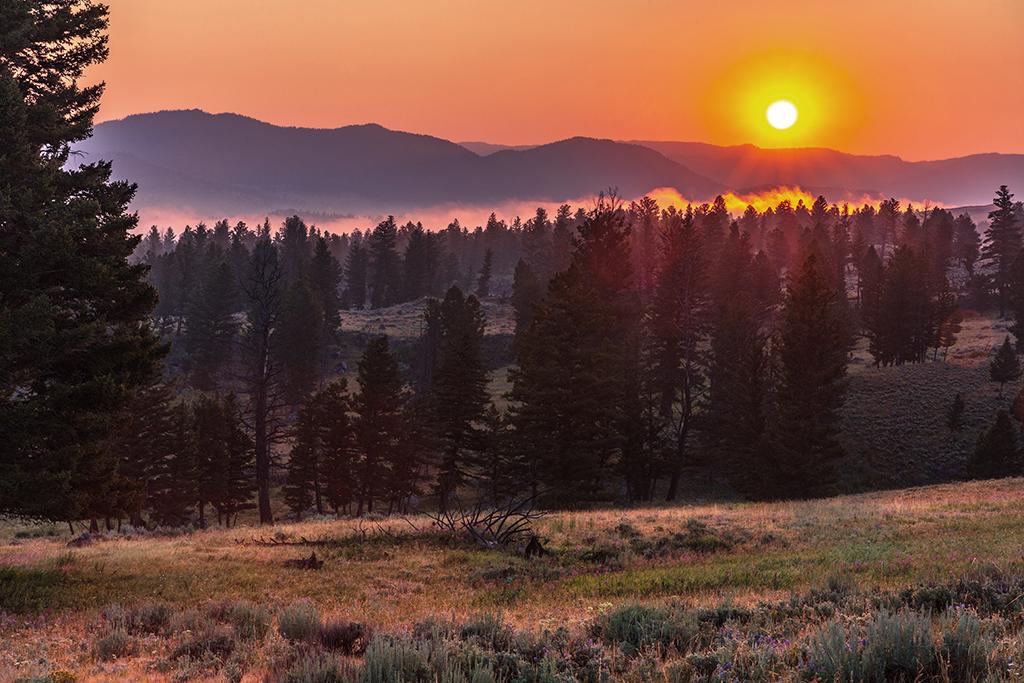
The colors of sunrise in Yellowstone National Park / Rebecca Latson
If you are on the road early in the morning, stop at as many view areas as possible before the crowds gather (the parking lot and views tend to fill rapidly by 9 a.m.). An early-morning summer visit to Calcite Springs Overlook provides sweet light and no crowds. In addition to getting wide-angle shots of the Yellowstone River and steaming Calcite Springs, you can use your telephoto lens or point-and-shoot telephoto mode to capture "telephoto landscapes" of the river and steam vents.

An early summer morning at the Calcite Springs Overlook, Yellowstone National Park / Rebecca Latson

A telephoto landscape of Calcite Springs and the Yellowstone River, Yellowstone National Park / Rebecca Latson
Stay a little longer at Calcite Springs and practice your observation skills while walking the short, paved nature trail from the view area back to the parking lot. Look for color contrasts, patterns, and textures such as bright green moss on brown wood. Use the trees along the trail as natural frames for the canyon walls and Yellowstone River.

Texture and color, Yellowstone National Park / Rebecca Latson

A natural frame around the Yellowstone River, Yellowstone National Park / Rebecca Latson
Drive further down the road to Tower Fall and make use of natural framing, again. You might even spot a little wildlife around you.
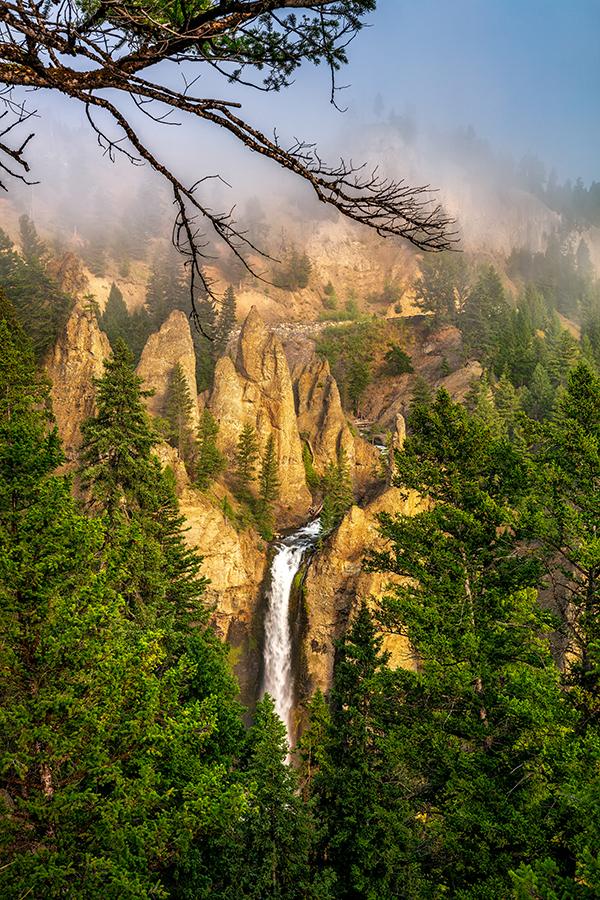
Early morning at Tower Fall, Yellowstone National Park / Rebecca Latson

Enjoying a little breakfast, Yellowstone National Park / Rebecca Latson
No matter which road you take through the park, you'll see stunning vistas of rolling, sunlit hills and mountainous backgrounds, layers of colors, abstract patterns, and various textures created by the trees and foliage, with rivers winding between steep canyon walls and/or through gently-undulating terrain.

A land of mountains, valleys, and undulating hills, Yellowstone National Park / Rebecca Latson

Yellowstone country, Yellowstone National Park / Rebecca Latson
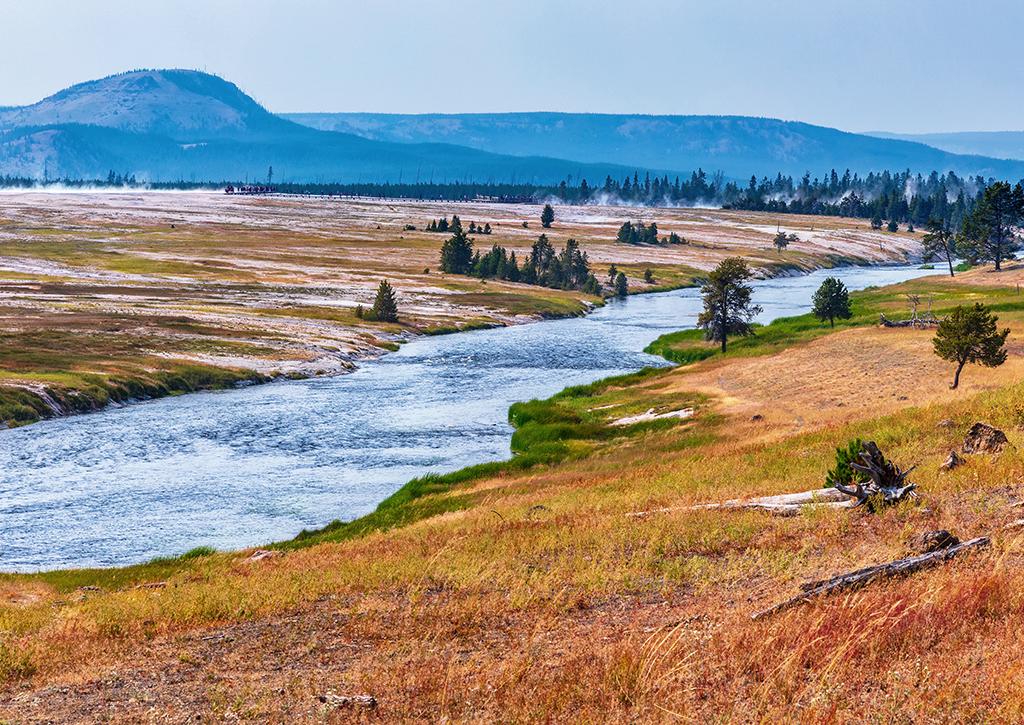
Looking toward Midway Geyser Basin, Yellowstone National Park / Rebecca Latson
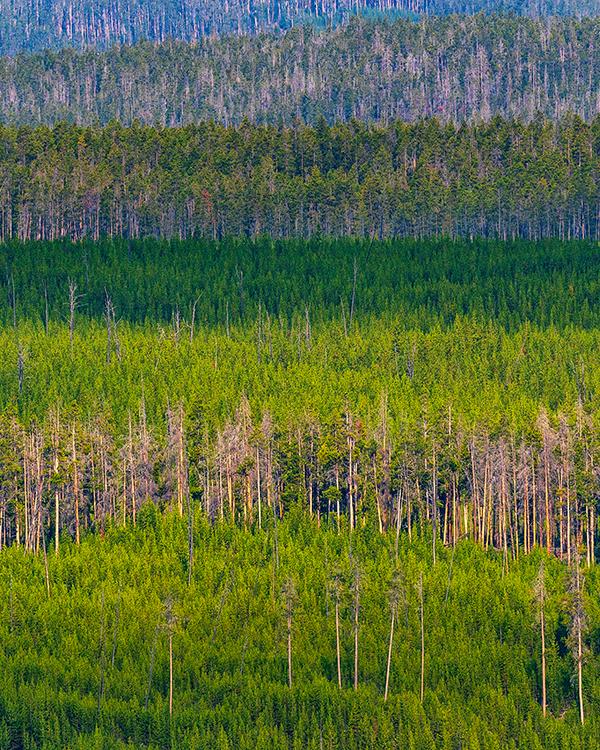
Layers of scenery, Yellowstone National Park / Rebecca Latson
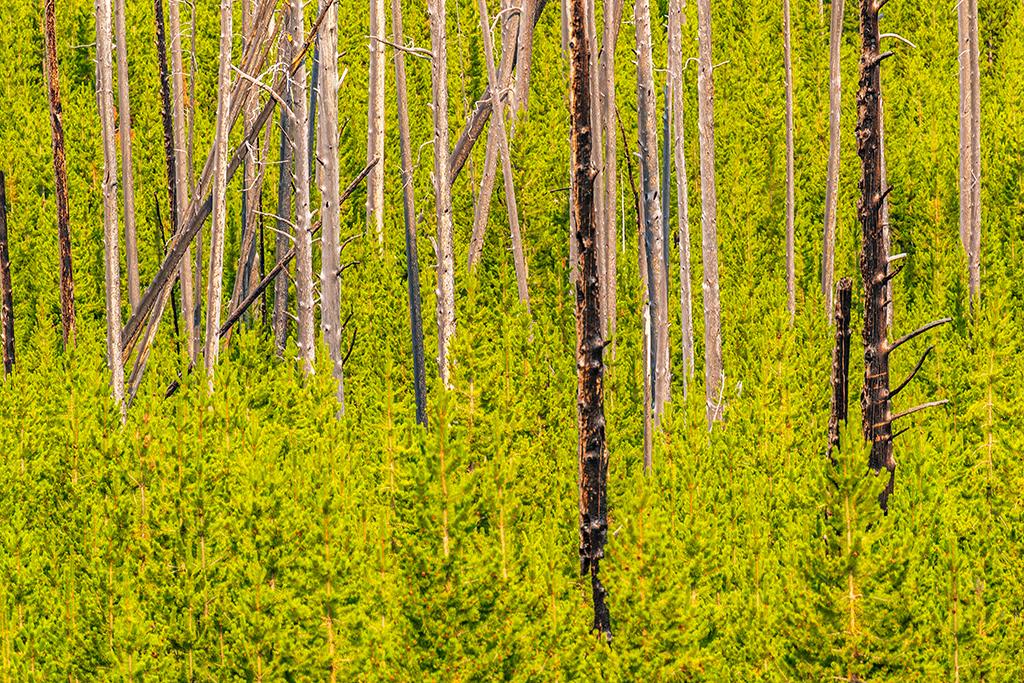
Abstract art in nature, Yellowstone National Park / Rebecca Latson
As I mentioned earlier, I managed to snag parking spots at Upper Geyser Basin, Biscuit Basin, Fountain Paint Pots Nature Trail, and Mammoth Hot Springs, where I photographed not only the blue-green hues of steaming thermal pools and the erupting waters of well-known geysers, but also the colorful results and curious textures of all that geothermal activity. If you visit these iconic spots, start your day early since mornings are ideal, not only for good lighting conditions and few crowds, but because, even in the summer, the temperatures are cool enough to accentuate the steam issuing from the hot springs and geyser vents. If you are fortunate enough to view an erupting geyser, make certain your camera's auto focus is set to track movement (the steam issuing from the vent). Use the "burst method" of keeping your finger pressed to the shutter button for several clicks to ensure at least one clear, sharp shot of Yellowstone's geothermal plumbing in action.

Before the crowds at Old Faithful, Yellowstone National Park / Rebecca Latson

Thar she blows! Yellowstone National Park / Rebecca Latson
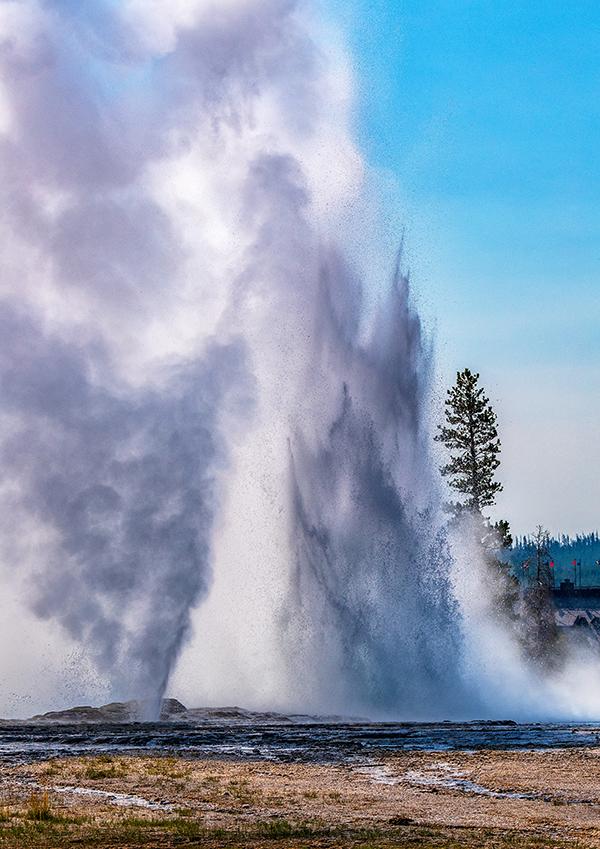
Columns of steaming water at Grand and Turban Geysers, Yellowstone National Park / Rebecca Latson

Crested Pool on a sunny day, Yellowstone National Park / Rebecca Latson

A boardwalk leading line at Upper Geyser Basin, Yellowstone National Park / Rebecca Latson

Ripples in a thermal pool at Biscuit Basin, Yellowstone National Park / Rebecca Latson

A little bubbler at Biscuit Basin, Yellowstone National Park / Rebecca Latson
By mid-morning, people will crowd the boardwalks and you'll more than likely be including them in your compositions. That's great! Why? Scale and reference. Your photo audience will find the addition of people and architecture helpful when gauging the size of a hot spring or erupting geyser.

Watching Castle Geyser erupt, Upper Geyser Basin, Yellowstone National Park / Rebecca Latson

A view along the Fountain Paint Pots Nature Trail, Yellowstone National Park / Rebecca Latson
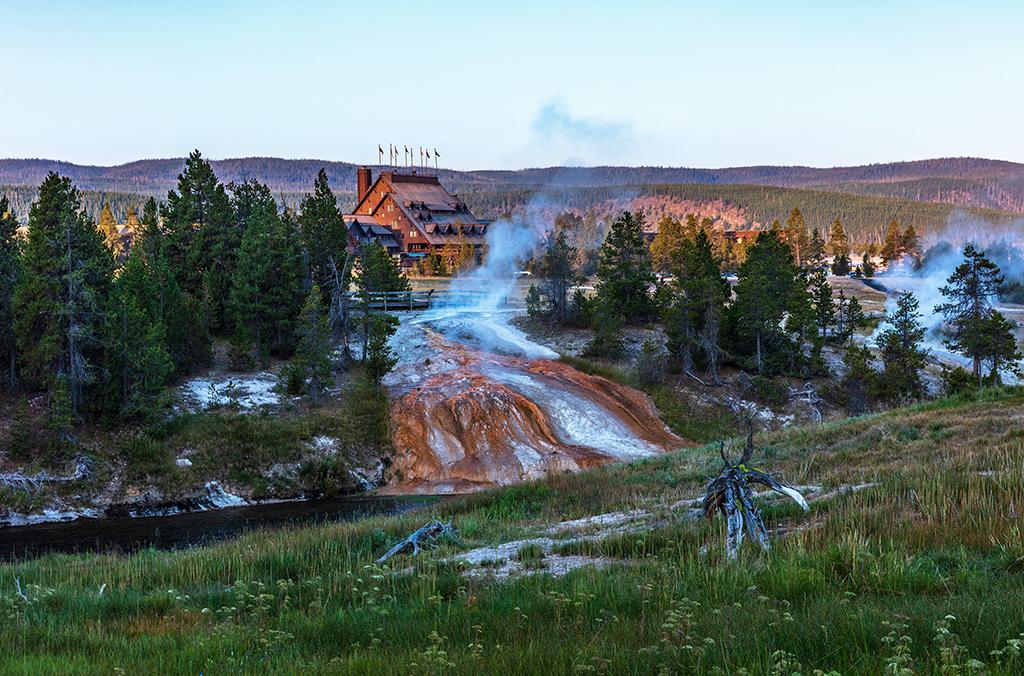
Old Faithful Inn and surrounding scenery, Yellowstone National Park / Rebecca Latson
Observation means keeping your eyes peeled for non-geyser subjects along the boardwalks. Summertime means you'll spot wildflowers, insects, and birds perched on boardwalk rails, in addition to all those colorful bacterial mats and veins leading away from geyser vents and hot springs.

Bog Gentian, Yellowstone National Park / Rebecca Latson

Flame Skimmer, Yellowstone National Park / Rebecca Latson

Little birdy, Yellowstone National Park / Rebecca Latson
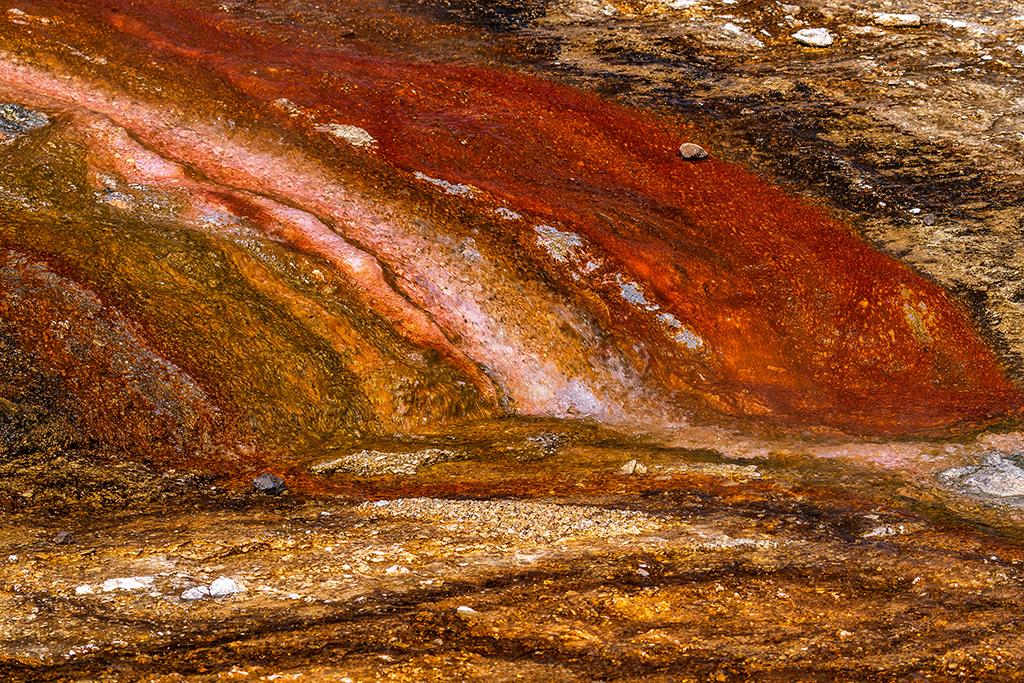
Bacterial colors, Yellowstone National Park / Rebecca Latson

Geyser "pearls," Yellowstone National Park / Rebecca Latson
Drive to Mammoth Hot Springs to spend time wandering up and down the boardwalks. To me, the boardwalks are reminiscent of old-time wooden roller coaster tracks, and they make great leading line shots to move your audience's eye from one end of your photo to the other. Those boardwalks also add a little scale and reference to that entire complex of hot springs and mineral deposits. Summer mornings provide beautiful light gilding the terraces with a bright yellow-gold hue. You might even spot killdeer standing camouflaged in the shallow, terraced waters.

The colors of Palette Spring, Yellowstone National Park / Rebecca Latson
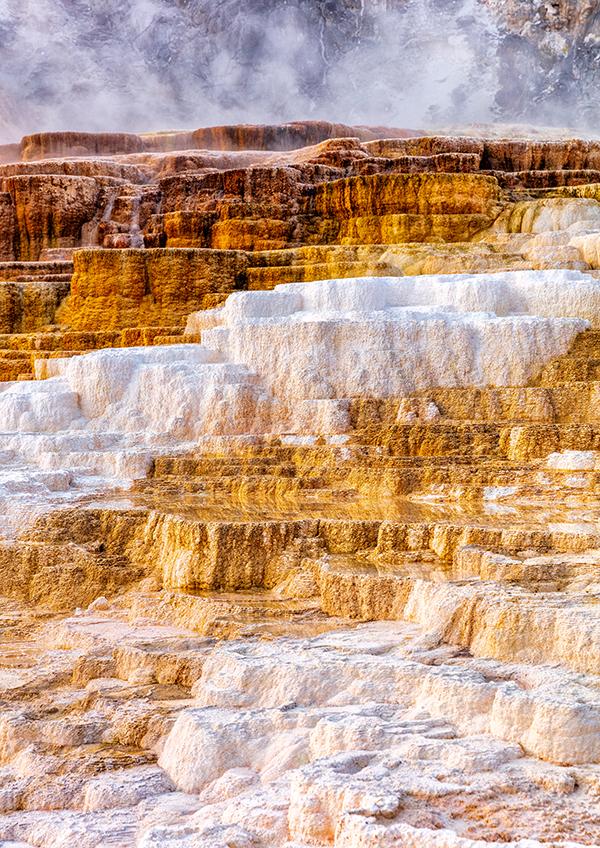
Terrace layers, Mammoth Hot Springs, Yellowstone National Park / Rebecca Latson
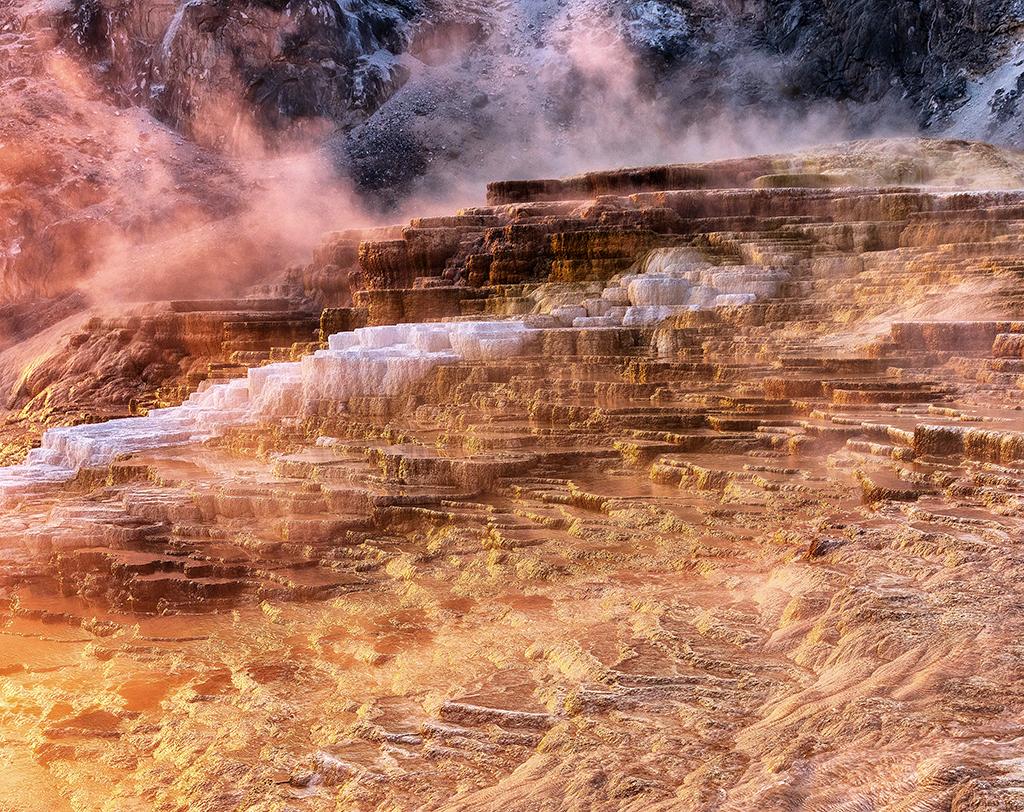
Sunrise gilding the terrace layers, Mammoth Hot Springs, Yellowstone National Park / Rebecca Latson

Camouflaged killdeer, Yellowstone National Park / Rebecca Latson

Canary Spring, Yellowstone National Park / Rebecca Latson
Mammoth Hot Springs is a great location for experimenting with your circular polarizing filter (CPL, or polarizer) to remove reflections from the water. A CPL filter works on the same principle as your sunglasses. If you aim your CPL-affixed camera lens at an angle to the sun, then rotate that outer ring on the filter, you'll see reflections and glare disappear, colors become a little more saturated and textures more pronounced. On the other hand, you might like the bright, golden reflection of the sun on the water and decide to not use your CPL at all. I tried shots with and without. Which one do you like better, or is it a toss-up?

Travertine-terraced springs - no polarizer, Mammoth Hot Springs, Yellowstone National Park / Rebecca Latson
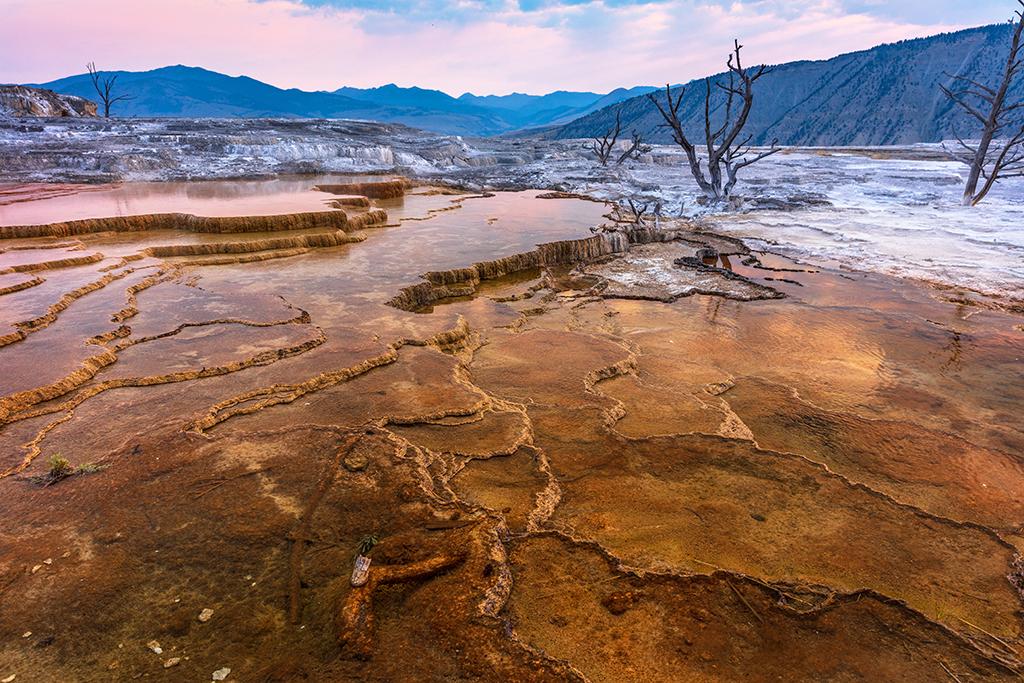
Travertine-terraced springs - with polarizer, Mammoth Hot Springs, Yellowstone National Park / Rebecca Latson
When visiting Yellowstone, if you are unable to see everything you planned to see, for whatever reason (weather, crowds, time), don't be disappointed. Remember there is so much more to this national park than just geysers and big wildlife. The beauty of this place is all around you. Just open your eyes and your camera’s viewfinder to the many possibilities.

Where will the boardwalk take you? Yellowstone National Park / Rebecca Latson




 Support Essential Coverage of Essential Places
Support Essential Coverage of Essential Places







Comments
Thanks for the wonderful photos and tips! If geyser spray can damage vehicle paint, I'm wondering if 'geothermal fog' presents a hazard to people or their cameras?
Thanks for the kind words, Tahoma. And, so far, so good with my own cameras. I figure the steam from Yellowstone vents carries particulates like the steam from vents at Hawai'i Volcanoes National Park. My standard procedure during visits to both of those parks was to wipe my cameras down with a clean cloth at the end of the day and do a check of the lenses, as well.
Beautiful photos, Becky.
Thank you for seeing the Yellowstone I grew up visiting. I'll watch for more.
Thanks for sharing your gorgeous shots. Not only did I learn a little about photography, I got to see a land I first fell in love with over 40 years ago.
One of your best articles! Thanks for sharing with us.
These photos bring back such good memories -- along with Bryce, it is a favorite park which we've visited twice. There is the beauty along with a veritable geology textbook
Thank you for sharing your beautiful pictures! We are going in August, makes me excited for our trip!